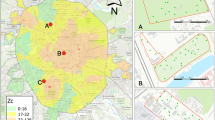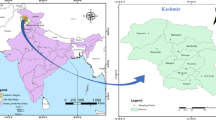Abstract
Three sets of soil samples were collected by the National Institute for Occupational Safety and Health and one set by South Dakota School of Mines & Technology from in and around the Slim Buttes Land Unit of the Sioux Ranger District of the Custer–Gallatin National Forest in the northwest of South Dakota. The rocks forming the Slim Buttes are sedimentary clays, sands and gravels including re-worked volcanic ash-falls in which the zeolite mineral erionite has crystallized during diagenesis in a fibrous form or morphology similar to that of asbestos. The samples were prepared using the fluidized bed asbestos segregator (FBAS) and analyzed by phase contrast microscopy (PCM) or transmission electron microscopy to detect the presence of mineral fibers. FBAS–PCM results compared to semi-quantitative polarized light microscopy (PLM) and X-ray diffraction analysis indicated a recovery of approximately 1% and a linear relationship that likely can be extrapolated to concentrations well below the 1% detection limit of PLM. There were small variations between a PCM count of 10 fibers to a count of 100 fibers (or a maximum of 200 microscopic fields of view), which indicates the possibility of rapid turnaround of results. Although the four sets of samples examined in this work were collected by slightly different techniques, some tentative conclusions can be drawn about the distribution of erionite in soils. Erionite was detected in almost every soil sample, even those taken several miles from the outcrop, but without any distribution indicating recent transportation from the current volcaniclastic sediment outcrops. Removal of more extensive volcaniclastic sediments through erosion may have resulted in remnant material in soils, including erionite crystals, but this possibility requires further study. Although we have demonstrated that erionite in soils can be detected through FBAS–PCM, we have not attempted to correlate those results with human inhalation exposure through activity-based sampling, and thus, any risk inherent in working these soils is unknown.







Similar content being viewed by others
References
ASTM (2013) Test method for determination of asbestos in soil (ASTM D7521-13). American Society for Testing and Materials (ASTM International), West Conshohocken, PA
Baris YI (1991) Fibrous zeolite (erionite)-related diseases in Turkey. Am J Ind Med 19:374–378
Beaucham C, Harper M, King B (2015) Evaluation of erionite and silica exposure. During forestry activities. National Institute for Occupational Safety and Health (NIOSH) Health Hazard Evaluation Program Report 2013-0061-3244
Campbell CL (2010) Letter to Dave Glatt, North Dakota Department of Health. Erionite Exposures in North Dakota—recommended actions. United States Environmental Protection Agency, Region 8, Denver, CO
Carbone M, Baris YI, Bertino P, Brass B, Comertpay S, Dogan AU et al (2011) Erionite exposure in North Dakota and Turkish villages with mesothelioma. Proc Natl Acad Sci 108(33):13618–13623
Deffeyes KS (1959) Erionite from Cenozoic tuffaceous sediments, central Nevada. Am Miner 44:501–509
Eakle AS (1898) Erionite, a new zeolite. Am J Sci 6:66–68
Earney TE and Baran Z (2016) A case study of medical geology: investigation of the occurrence of erionite and potential enrichment zones at Reva Gap in Harding County, SD. Paper No. 50-3 GSA Ann. Meeting Denver, CO
Forsman N (1986) Documentation and diagenesis of tuffs in the Killdeer Mountains, Dunn County, North Dakota, Dakota Geological Survey Report of Investigation 87:16
Goodman BS (2010) Erionite, a naturally occurring fibrous mineral hazard in the tristate area of North Dakota, South Dakota, and Montana. In: 62nd Annual meeting of the geological society of America Rocky Mountain Section, Rapid City, SD. GSA Abstracts with Programs 42(3) Session 4–5
Januch J, Brattin W, Woodbury L, Berry D (2013) Evaluation of a fluidized bed asbestos segregator preparation method for the analysis of low-levels of asbestos in soil and other solid media. Anal Methods 5:1658–1668
Lowers HA, Adams DT, Meeker GP Nutt CJ (2010) Chemical and morphological comparison of erionite from Oregon, North Dakota, and Turkey. United States geological survey open-file report 2010–1286, Reston, VA
Martin JE, Sawyer JF, Fahrenbach MD, Tomhave DW, Schulz LD (2004) Geologic map of South Dakota. South Dakota Geological Survey
Matassa R, Familiari G, Relucenti M, Battaglione E, Downing C, Pacella A, Cametti G, Ballirano P (2015) A deep look into erionite fibres: an electron microscopy investigation of their self-assembly. Sci Rep 16(5):16757
Mumpton FA, Ormsby WC (1978) Morphology of zeolites in sedimentary rocks by scanning electron microscopy. Clays Clay Miner 24:1–23
NIOSH (1994a) Asbestos and other fibers by PCM (NMAM 7400) Fourth Edition National Institute for Occupational Safety and Health (NIOSH), Cincinnati, OH. http://www.cdc.gov/niosh/docs/2003-154/pdfs/7400.pdf Accessed 17 Jan 2017
NIOSH (1994b) Asbestos and other fibers by TEM (NMAM 7402) Fourth Edition National Institute for Occupational Safety and Health (NIOSH) Cincinnati, OH. http://www.cdc.gov/niosh/docs/2003-154/pdfs/7402.pdf Accessed 17 Jan 2017
Occella E (1994) Analysis of asbestos in bulk materials by X-ray diffraction: influence of grinding methods on the result. KONA Powder Part J 12:43–52
Roy S (1993) The depositional history of the Arikaree formation in the Ekalaka Hills, Center County, MT. 6th Keck Research Symposium in Geology, Whitman College, Walla Walla, WA, pp 115–118. http://keckgeology.org/files/pdf/symvol/6th/Montana/roy.pdf Accessed 17 Jan 2017
Ryan PH, Dihle M, Griffin S, Partridge C, Hilbert TJ, Taylor R, Adjei S, Lockey JE (2011) Erionite in road gravel associated with interstitial and pleural changes—an occupational hazard in western United States. J Occup Environ Med 53(8):892–898
Saini-Eidukat B, Triplett JW (2014) Erionite and offretite from the Killdeer Mountains, Dunn County, North Dakota, USA. Am Miner 99:8–15
Stone JJ Stetler LD (2009) Assessment of environmental impacts near abandoned uranium mines within the Cave Hills and Slim Buttes complexes, Custer National Forest, South Dakota. In: Proceedings from the 2009 joint conference, Annual Meeting of the American Society of Mining and Reclamation and 11th Billings Land Reclamation Symposium, Billings, MT
USDA (2004) Soil survey of harding county, South Dakota. USDA soil conservation service in cooperation with United States Department of Agriculture (USDA) Forest Service and South Dakota Agricultural Experimental Station. https://www.nrcs.usda.gov/Internet/FSE_MANUSCRIPTS/south_dakota/SD063/0/Harding.pdf Accessed 17 Jan 2017
USEPA (1993) Test method for the determination of asbestos in bulk building materials. United States Environmental Protection Agency (USEPA), EPA/600/R-93/116 Washington, DC
USEPA (2010a) Analytical results report; Dunn County erionite, Killdeer, Dunn County, North Dakota. United States Environmental Protection Agency (USEPA), Region 8, Superfund Technical Assessment and Response Team 3. TDD No. 0606-02, Contract No. EP-W-05-050
USEPA (2010b) Sampling, sample preparation and operation of the fluidized bed asbestos segregator United States Environmental Protection Agency (USEPA), OEAFIELDSOP-102 Region 10
USEPA (2013) Bulk sampling for asbestos United States Environmental Protection Agency (USEPA) SESDGUID-104-R1 Athens, GA
Van Gosen BS, Blitz TA, Plumlee GS, Meeker GP, Pierson MP (2013) Geologic occurrences of erionite in the United States: an emerging national public health concern for respiratory disease. Environ Geochem Health 35(4):419–430
Acknowledgements
The authors would like to thank Eun Gyung Lee, Lorenzo Cena, Timur Khaliullin and Autumn Menas (NIOSH, HELD), with their assistance in the fiber counting variation experiment, Kurt Hansen, (USFS), for assistance with sample collection, Catherine Beaucham (NIOSH, DSHEFDS) for providing soil samples and manuscript review, and Lynn Woodbury (CDM Smith) for manuscript review.
Author information
Authors and Affiliations
Corresponding author
Electronic supplementary material
Below is the link to the electronic supplementary material.
Rights and permissions
About this article
Cite this article
Farcas, D., Harper, M., Januch, J.W. et al. Evaluation of fluidized bed asbestos segregator to determine erionite in soil. Environ Earth Sci 76, 126 (2017). https://doi.org/10.1007/s12665-017-6438-7
Received:
Accepted:
Published:
DOI: https://doi.org/10.1007/s12665-017-6438-7




